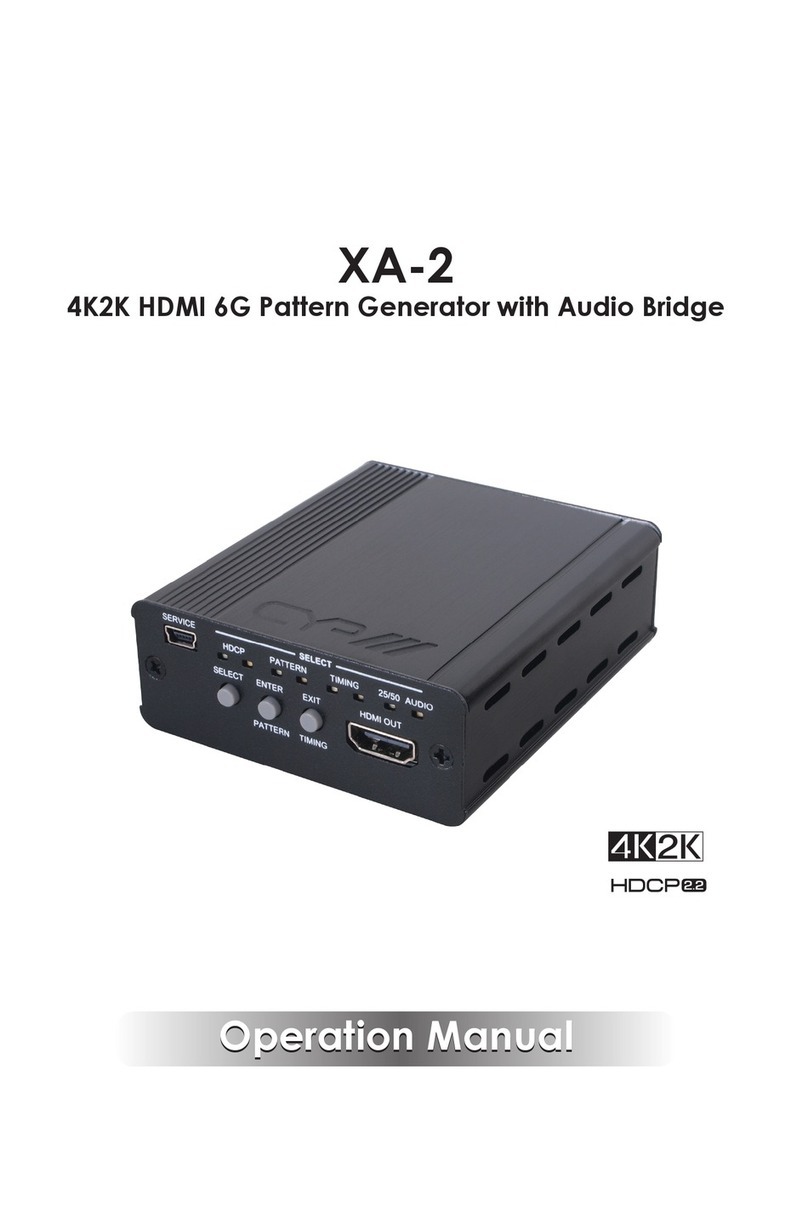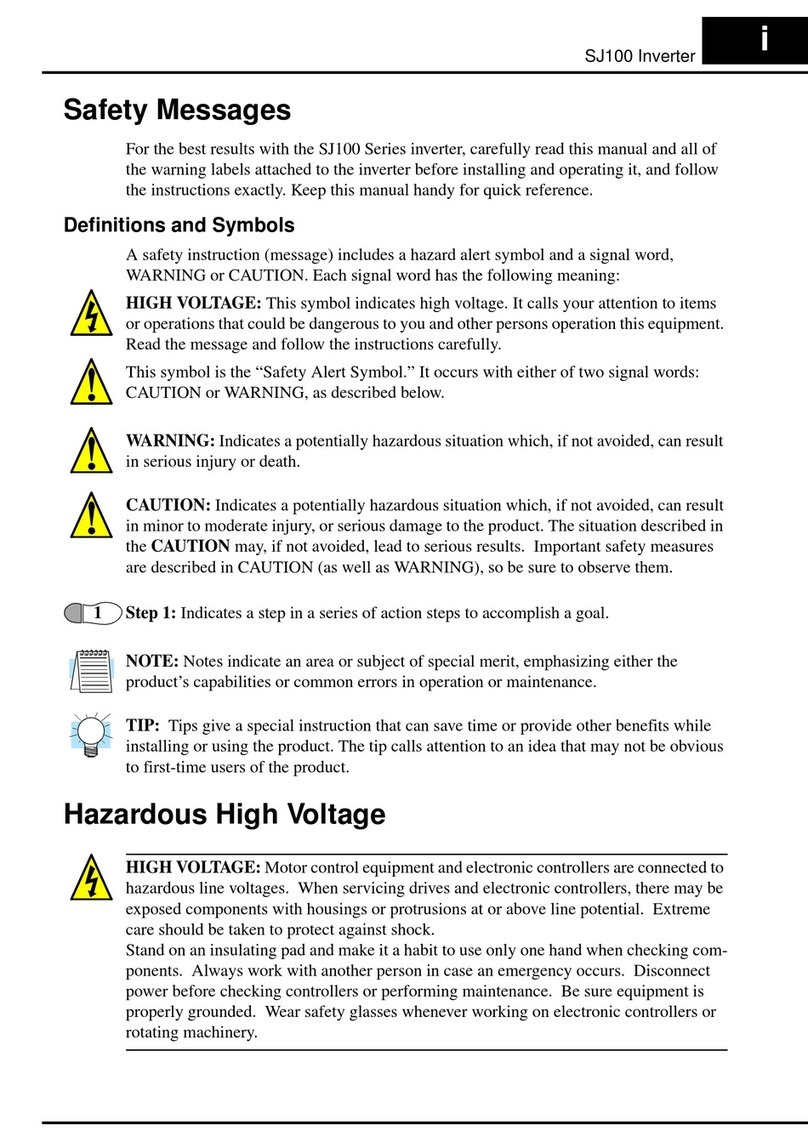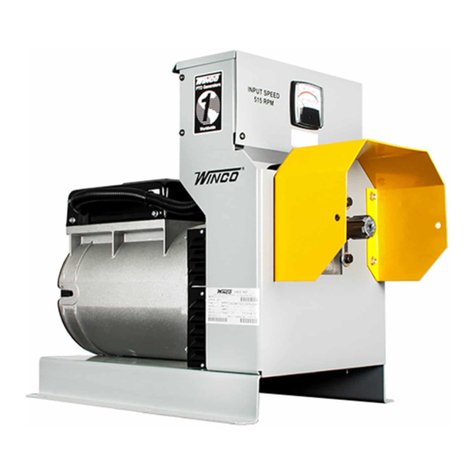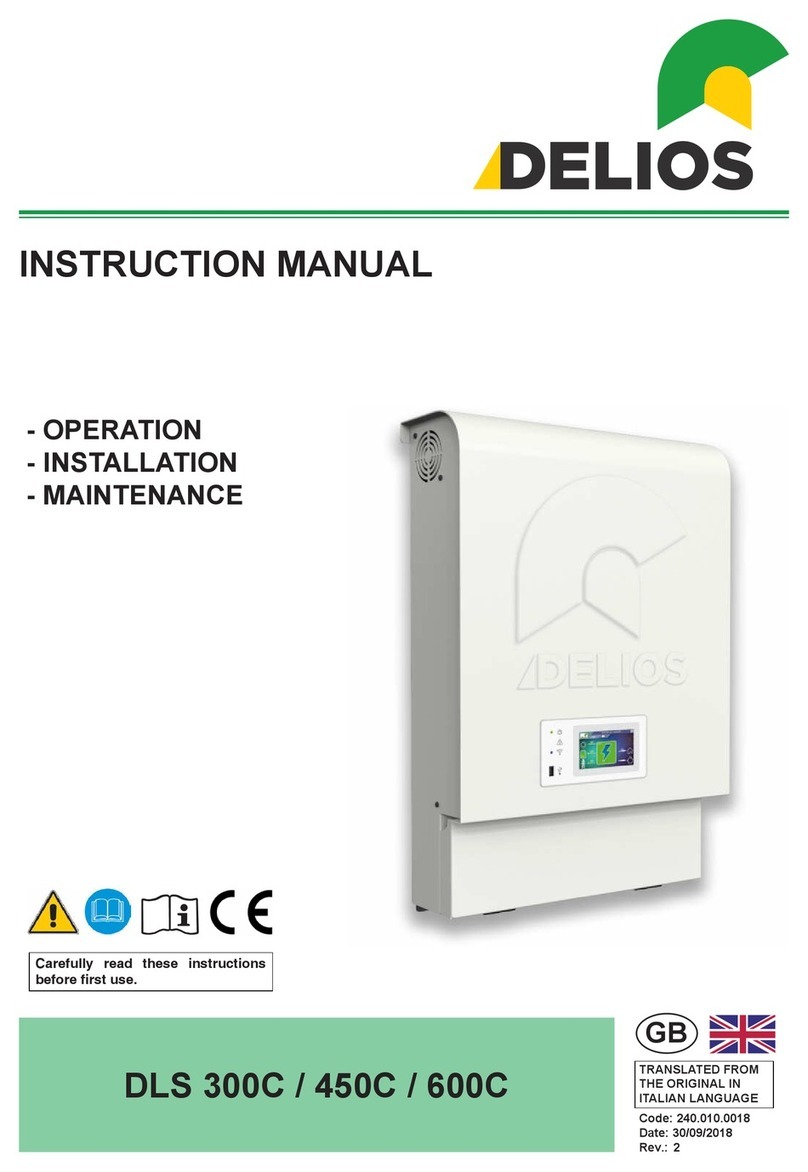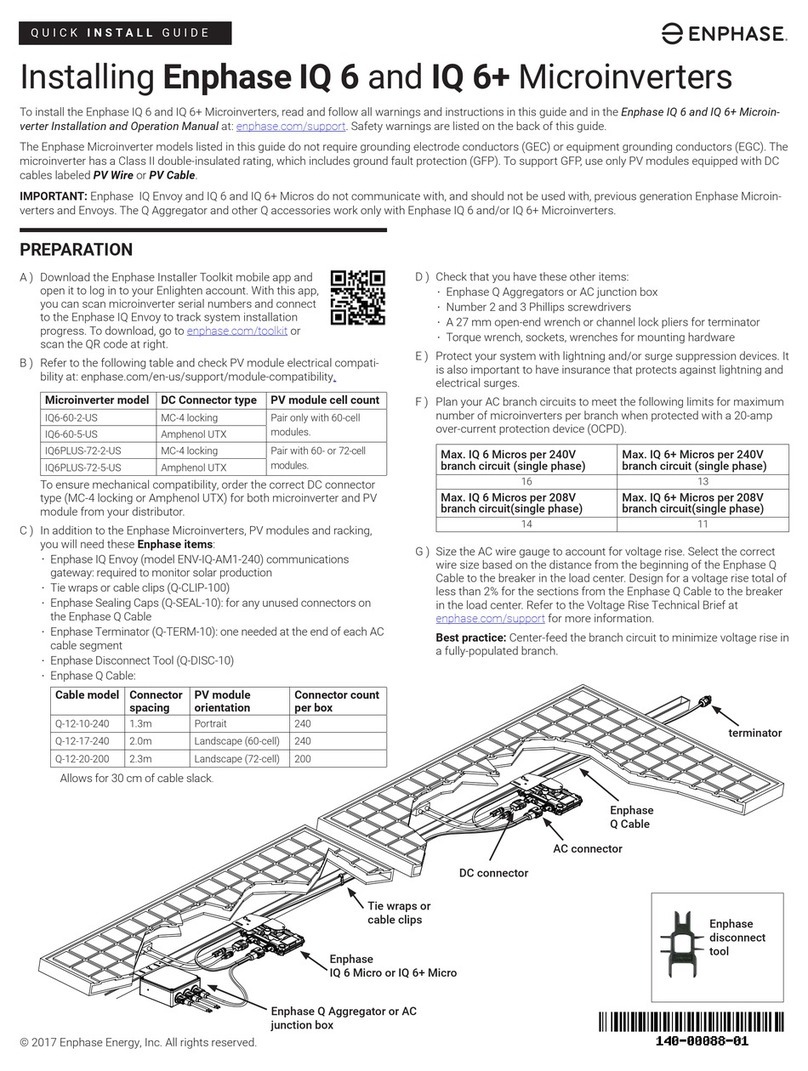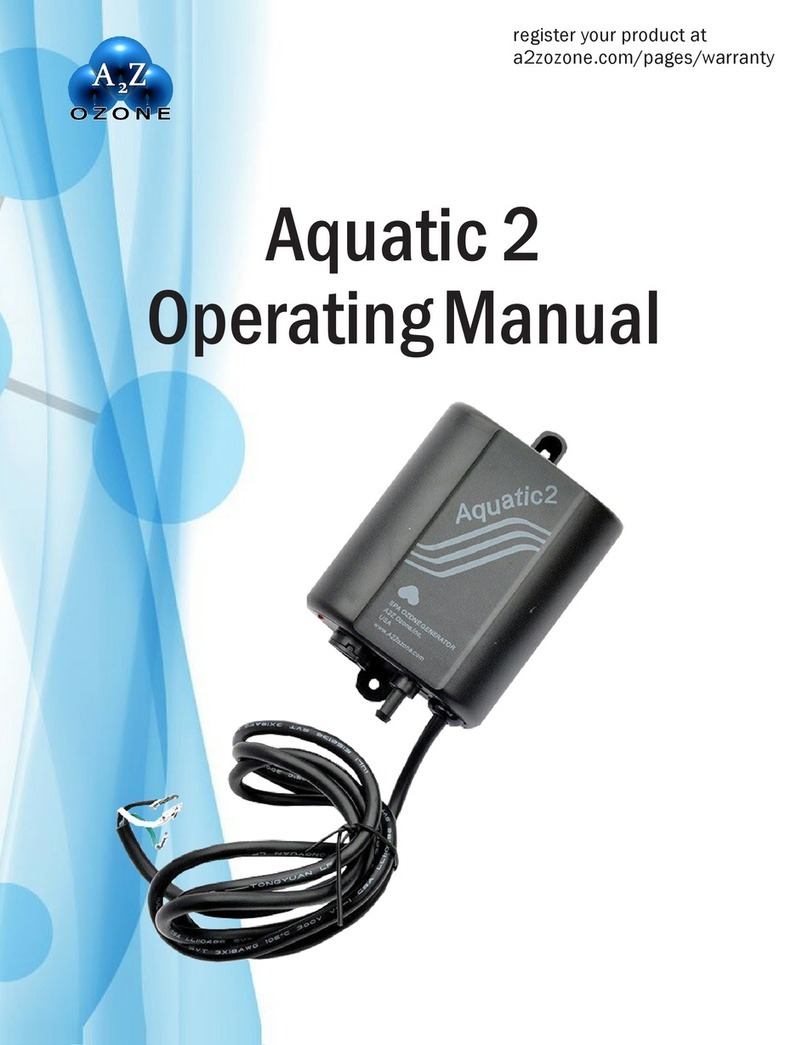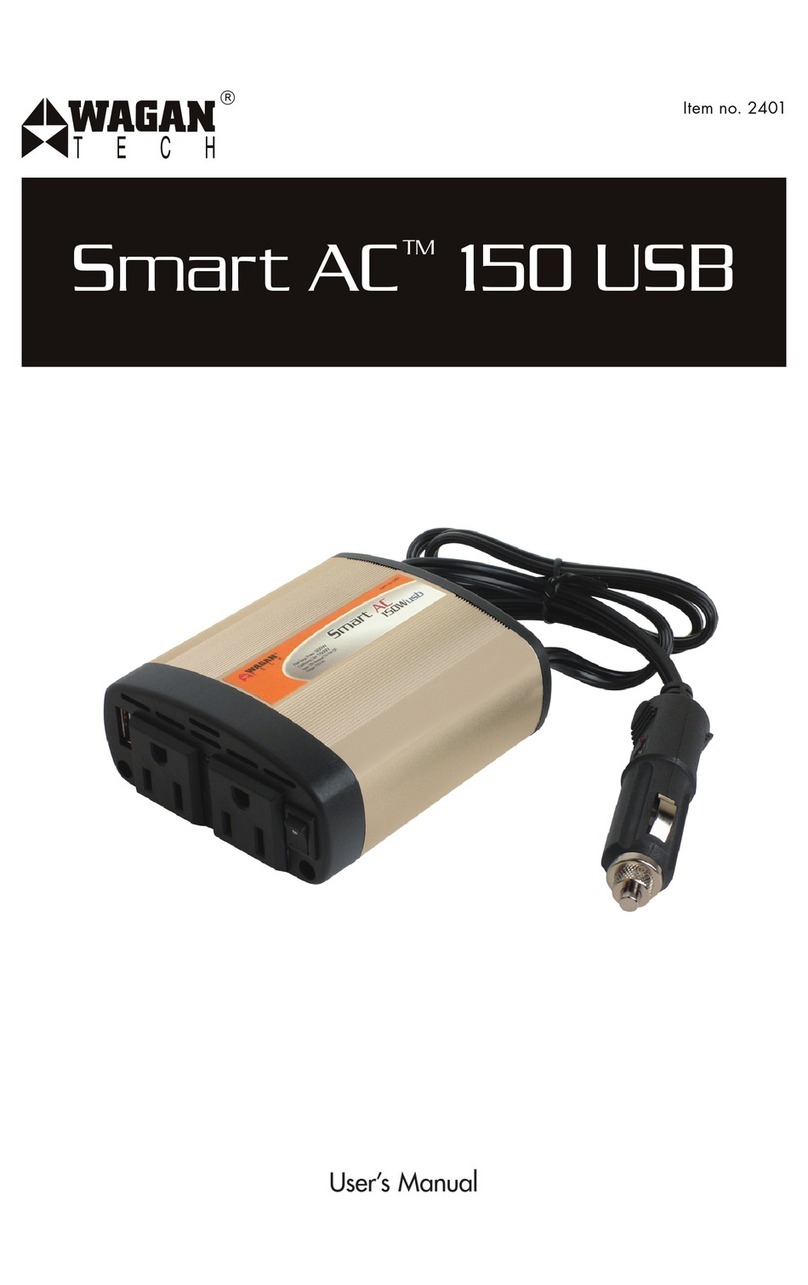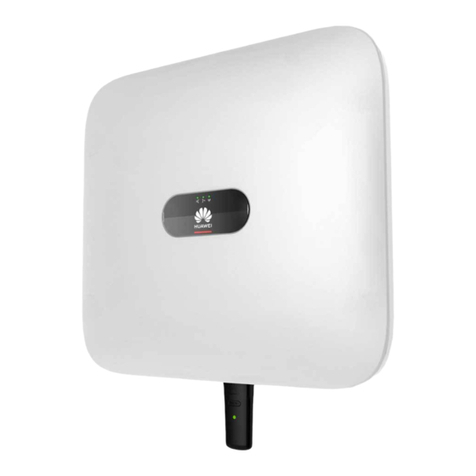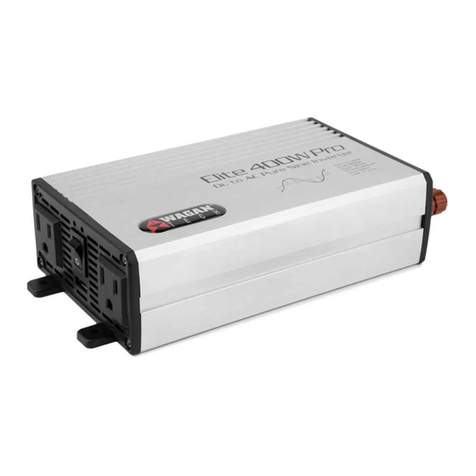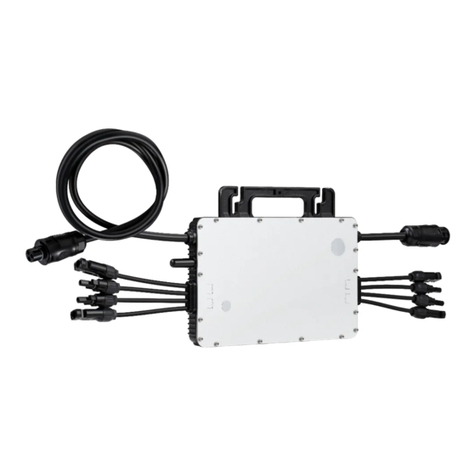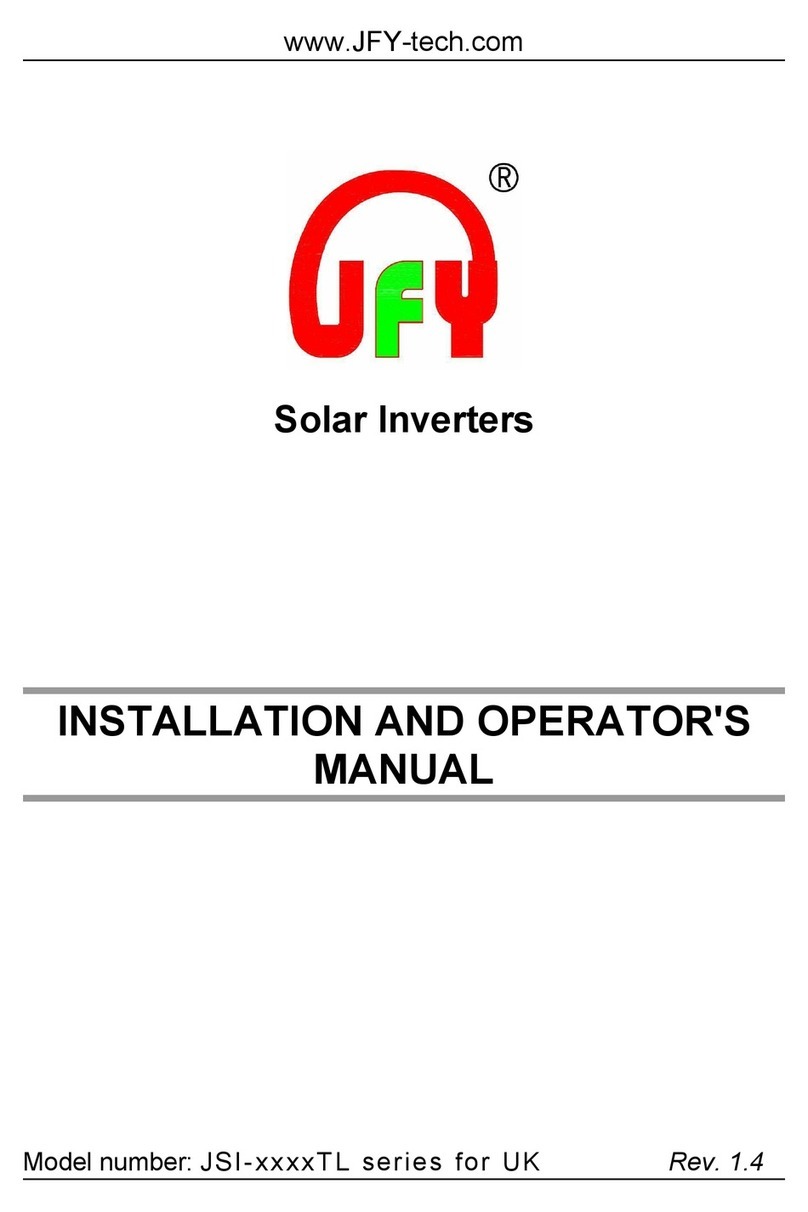AE Conversion INV315-50EU User manual

Micro-Inverter
English
INV315-50EU

310.2018 INV315-50EU
Installation and Operation Manual for INV315-50 RF
Copyright by AEconversion GmbH & Co. KG
Table of Contents
1.0 About this Manual 4
1.1 Symbols used 4
1.2 Scope 4
1.3 Target Audience 4
2.0 Safety and Regulations 4
2.1 General Information and Safety Instructions 4
2.1.1 Storage, Transportation, Operation & Maintenance 4
2.1.2 Assembly, Installation and Electrical Connection 4
2.2 CE Mark 5
2.3 Label 5
3.0 Notes on Liability, Warranty and Service 5
3.1 Intended use and liability 5
3.2 Guaranty and Warranty 5
3.3 Service 5
4.0 Legal regulations and technical guidelines 6
4.1 Derating 6
4.1.1 Derating as a function of input voltage 6
4.1.2 Derating as a function of ambient temp 6
5.0 Product Description 6
5.1 Scope of Delivery 6
5.2 Dimensions 7
5.3 LED-Display 7
5.4 Protection Concepts 7
5.5 Network and System Protection 7
6.0 Operating Conditions 8
6.1 Dimensioning of the PV-Generators 8
7.0 Installation 8
7.1 Installation on PV-racking 9
7.2 Mounting Alternatives 9
8.0 Connections 10
8.1 Connections Overview 10
8.1.1 Connections 10
8.2 AC-Connection 10
8.2.1 AC-Connection of many devices 11
8.3 DC-Connection 11
9.0 Initial Operation 12
9.1 Registering with Utility Company 12
9.2 Acceptance of the plant by the Utility Company 12
10.0 Switching o the Inverter 12
11.0 External Limiting 13
12.0 Further Information 13
12.1 Disposal 13
12.2 Care 13
12.3 Laws, Regulations and Technical Rules 13
13.0 Technical Data 13
Appendix
Technical Data for INV315 14
Derating Diagrams 15
Declaration of CE-Conformity 16
Overview: Country Specic Data 17

4 5INV315-50EU 10.201810.2018 INV315-50EU
1.0 About this Manual
This manual describes the installation and operation of the
micro-inverter. The installation and operating instructions
should always be kept within reach of the inverter.
1.1 Symbols used
This manual uses the following types of safety symbols that are
to be noted for the installation and operation of the inverter:
Danger!
The term„danger“ describes an issue which, if
ignored can cause personal injury.
Attention!
With the term„attention“, a circumstance is listed
which may cause property damage if disregarded.
Note!
The term„Note“ lists an issue for which its
observance leads to an improvement in the
operation.
1.2 Scope
This manual applies to the following micro-inverters:
• INV315-50EU
1.3 Target Audience
This manual is for the installer and operator of the types of
inverters listed in 1.2.
Attention!
This guide assumes knowledge corresponding
to a recognized professional qualication as an
electrician.
2.0 Safety and Regulations
The micro-inverter converts the power generated by the PV
modules from direct current into grid compliant alternating current.
For damages resulting from failure to follow these instructions, we
assume no liability. When installing the inverter, please note the
following instructions for all assemblies and components of the
system.
3.1 Intended use and liability
The AEconversion Micro-Inverter converts the power generated
by the PV modules from direct current into grid compliant
alternating current and supplies it to the power network.
Any other or additional use is considered improper. The
manufacturer / supplier shall not be liable for any resulting
damages. The risk is carried solely by the operator.
Intended use also includes compliance with the instructions and
installation manual. Some of the documents that you need for
the registration and inspection of your photovoltaic system are
included in the installation instructions.
The inverter can be operated with a permanent connection to
the power network. The inverter is not designed for mobile use.
Changes to the inverter are generally prohibited. For any
changes in the system a qualied electrician must be called in.
3.2 Guaranty and Warranty
AEconversion grants an implied warranty of 2 years to the
inverter from date of purchase. Furthermore, AEconversion
provides an additional limited warranty for several years. For
warranty questions, please contact your retailer or installer. If
your device has a defect or malfunction during the warranty
period, please also contact your retailer or installer.
Warranty claims are excluded for:
• alterations or repairs to the unit
• opening of the inverter, for example by unscrewing the cover
• improper use of device
• improper and non-standard installation
• improper operation
• operating the equipment with defective safety devices
• impact of foreign objects and force majeure (lightning, surge,
storm, re)
• inadequate or nonexistent ventilation of the device
• disregarding of safety regulations
• shipping damage
• Use of non-original PV module connectors from the HELIOS
H4 product line of the company Amphenol.
3.3 Service
We have already set high standards in the development phase
on the quality and longevity of the inverter. In spite of all quality
assurance activities, disturbances may occur in exceptional
cases. In these cases, you will get the maximum possible support
to eliminate the problem quickly and without bureaucratic
complexities. Please contact our service department directly.
AEconversion -Service Telefon: +49 2927 9194-10
In order for the service department to respond quickly and
correctly, the following information is absolutely necessary.
1) Details of the inverter:
Product description, type and serial number of the inverter.
This information can be found on the label on the device.
Short description of the error:
• Did the fault occur immediately at the start or at a later time?
• Is the fault is reproducible or occurs only sporadically?
2.1 General Information and Safety Instructions
In order to ensure faultless and safe operation of this equipment,
proper transport, expert storage, installation, operation
and maintenance is required. During the operation of this
equipment, certain equipment parts carry hazardous voltages
that can cause serious injury or death. Always follow the
following instructions to minimize the risk of injury or death.
2.1.1 Storage, Transportation, Operation and Maintenance
For storage, transport, operation, and maintenance, the
following warnings are to be noted:
Danger!
- Proper grounding, wire sizing and appropriate
short-circuit protection must be provided to
ensure safe operation.
- Never remove the solar generator from the
inverter, while it is connected to the electricity
network.
- Make sure before carrying out visual
inspections and maintenance, that the power
supply is switched off and secured against
restarting.
- Please note the threats, warnings, and
precautions given in these operating and
installation instructions.
Attention!
- Do not under any circumstances interfere with or
manipulate the inverter or any other parts of the
system.
- Attention!
Inappropriate alterations can cause damage!
- All contacts should be kept dry and clean!
- Transport the inverter only in the given
packaging.
2.1.2 Assembly, Installation and Electrical Connection
The following warnings must be observed:
Danger!
Installation of this unit must comply with the
safety regulations (eg DIN, VDE) and all other
relevant national or local regulations.
- The assembly is run exclusively by persons who
can demonstrate a recognized professional
qualification as an electrician.
- If you mount the inverter at high altitude, avoid
possible falling risks.
- Do not plug electrically conductive parts into the
plugs and sockets! Tools and working conditions
must be dry.
- The electrical connection to the central building
should be performed only by a licensed electrician.
Attention!
- Do not under any circumstances interfere with or
manipulate the inverter or any other parts of the
system.
- Attention!
Inappropriate alterations can cause damage!E Mar
2.2 CE Mark
The CE mark documents that according to the label the
inverter fullls the following essential requirements of relevant
directives:
• Directive on the Electromagnetic Compatibility with the
Directive 2004/108/EC
• Low Voltage Directive (Directive 2006/95/EC)
(See page 18 for declaration of CE-Conformity)
2.3 Label
The label is located on the top side of the inverter. The
information on the label includes technical data as well as type
and serial number of the device.
Safety instructions on the label are listed and explained below:
Danger!
The term„danger“ describes an issue which, if
ignored can cause personal injury.
Attention!
With the term„attention“, a circumstance is listed
which may cause property damage if disregarded.
Instructions for use!
Under„Instructions for Use“, it is pointed out that
installation and operating instructions are to be
read and understood before installation or repair.
Caution, hot surface!
Under„Caution, hot surface“ should be noted that
surfaces of equipment may be hot and create a
burn hazard.
Special disposal instructions!
With„Note Separate Disposal“, it is pointed out
that this product may not be disposed of with
normal garbage. An improperly conducted
disposal can lead to damage to the environment.
3.0 Notes on Liability, Warranty and Service
Remarks on liability, warranty and service are listed hereafter.

6 7INV315-50EU 10.201810.2018 INV315-50EU
performance. If the performance of one PV-module drops, due
to shading or module mismatching for example, the modules in
the same string are aected negatively. Through the individual
connection in PV-systems using micro-inverters the PV-modules
work independently, each at their maximum performance to
increase energy harvest.
The“plug-and play”-system eliminates connection mistakes,
making the installation safe and easy. There are no high voltage
DC circuits to handle and installation time and costs are reduced.
Installations are eective ranging from small family houses to
large oce fronts and can be installed on any available space,
regardless of orientation, shading or module tolerances. Each
system can be rearranged or upgraded with more PV-modules
when needed, for example with performance expansion or
building modications.
With the micro-inverter, it is possible to monitor the
performance of PV-systems on modular basis, which enables
comprehensive monitoring and fast problem recognition. In that
way, not only an increase in energy earning can be provided, but
also a decrease in energy losses can be achieved by detecting
and localizing problems quickly and eectively.
The housing of the micro-inverter is IP65 protected and
designed for operating temperatures from -25 ° C to 70 ° C. If the
temperature inside the case exceeds a certain value, the inverter
will reduce the maximum power to protect itself. Systems with
micro-inverters are easy to design and install. Each inverter can
be mounted to the mounting bracket below the PV modules,
however, recommended is a place where a service can be
performed easily.
Other mounting options are listed in Section 7.0.
An overview of the technical data of the inverter can be found
on pages 15.
5.1 Scope of Delivery
The package includes:
• Inverter
• End Caps (depending on version)
• Quick Start Guide and further information on CD
• What environmental conditions (radiation) were present at the
time of the error?
2) Information about the PV-generator:
• What module manufacturer and type of module was installed?
• What is the schematic of the PV-System?
4.0 Legal regulations and technical guidelines
The legal regulations and technical guidelines are listed below.
4.1 Derating
Derating is the operation of a machine at less than its rated
maximum power in order to prolong its life or safety reasons,
which is described for the micro-inverter hereafter.
4.1.1 Derating as a function of input voltage
Due to the maximum value of the input current from the
PV module of 11A, a maximum power results which can be
transformed by the inverter depending on the input voltage.
The limit of 11A is limited by the inverter and cannot be
exceeded. Similarly, the maximum load of the PV module is
limited to 250W/350W/500W (depending on Inverter-Version).
This results in the following gradient of the maximum absorbed
power as a function of the input voltage from the PV module.
See Graph Derating diagram P pv / I pv on page 17
4.1.2 Derating as a function of ambient temp. / wind speed
Dierent environmental conditions result depending on the
installation of the inverter. The ambient temperature and air
ow around the inverter aect the inverter‘s performance
capabilities. In the inverter, a power control as a function of
temperature is integrated. The following charts represent
the maximum input power of the inverter over the ambient
temperature and wind speed.
See Graphs on pages 17:
• Derating diagram Ppv / T ambient 0m/s Wind Speed
• Derating diagram Ppv / T ambient 0,1 m/s Wind Speed
Please note that the performance capabilities of your PV module
decreases with increasing module temperature, in general with
about 0.4 % / °C. That means, a module with 330W under STC
conditions of 70°C and 1000 W/m² provide only a maximum of
271W.
5.0 Product Description
The AEconversion Micro-Inverter is individually connected to
one or two PV-module, depending on technical specications,
and converts the direct current into grid compliant alternating
current. Through the individual conversion at each module, the
sun’s energy can ideally be used. In addition, the micro-inverter
solves another widespread problem in conventional systems.
Because of the series connection in PV-systems using string- or
central-inverters, the PV-modules are codependent concerning
5.2 Dimensions
Typ Width
[mm]
Depth
[mm]
Height
[mm]
INV315-50EU 385 155 30
INV315-50EU
Without mounting
plate
385 109 30
5.3 LED-Display
During normal operation, the PV generators produce a voltage
when sucient daylight or sunlight is present. If this voltage at
a certain level and corresponding time period is applied to the
inverter, the inverter starts to feed into the grid. The inverter is
equipped with an LED, which gives information on the operating
status and causes for non-operation.
Feeding Operation:
Depending on the power the blink frequency is increasing. The
following blink frequencies show percentages as a function of
the device power:
0% to 3% LED 0.5 sec.„ON“ 2 sec.„OFF“
3% to 30% LED 0.5 sec„ON“ 1 sec.„OFF“
30% to 60% LED 0.5 sec„ON“ 0.5 sec„OFF“
60% to 85% LED 0.5 sec„ON“ 0.2 sec„OFF“
85% to 100% LED continuously„ON“
Non-feeding Operation:
When in non-feeding operation, the LED indicates certain
output stages, which are described hereafter. These can be used
to troubleshoot the inverter in case of malfunction. Each stage
indication starts with the following sequence:
Sequence starts: 5 sec„ON“, 2 sec “OFF“
Output Stages:
Synchronization running:
LED 1sec„ON“ 0.5sec„OFF“, one pulse
AC Voltage not in tolerance range:
LED 1sec„ON“ 0.5sec„OFF“, two pulses
DC Voltage not in tolerance range:
LED 1sec„ON“ 0.5sec„OFF“, three pulses
AC and DC Voltage not in tolerance range:
LED 1sec„ON“ 0.5 sec„OFF“, four pulses
Internal over-temperature:
LED 1sec„ON“ 0.5 sec„OFF“, ve pulses
Sequence ends: 2 seconds„OFF“.
Insulation measurement on the PV side:
In feed-in operation, a too low insulation resistance between
PV and AC is signaled by a fast blinking. For this purpose, the
ashing frequency is interrupted approx. every 15s to indicate
the feed-in power and a high frequency ashing is set for
approx. 2s
5.4 Protection Concepts
The following monitoring concepts and protection plans are
included in the AEconversion scope of devices:
• Surge / varistors to protect the power semiconductor
• temperature monitoring
• EMC lter to protect the inverter against high-frequency
power disturbances
• varistors to earth on the mains side to protect the inverter
against surge voltages
• BISI (Bi-directional security interface ) network monitoring
for personal protection and to prevent islanding according to
VDE0126-1-1 / VDE AR-N 4105 / IEC62116
• Isolation monitoring of the PV input
5.5 Network and System Prote
According to the VDE-AR-N 4105, the last ve fault conditions
of the network and system protection as well as the set action
values and times must be readable. For the device versions
without a communication interface and with integrated light
conductors, the data output is realized through the LED.
For devices with a communication interface, the data is
additionally available via the integrated interface.
Activation of the output via light conductors:
• turn o AC
• LED signals the start of the output sequence through 5
seconds„ON“
• LED puts out the data as a pulse pattern (duration 50 sec)
• LED signals the end of the output sequence through 5
seconds„ON“
• LED turns to normal mode signaling
The LED output sequence must be recorded via video
(smartphone, digital camera, etc.) with a resolution of
680x480DPI. This video is then analyzed using the computer
B
H
T

8 9INV315-50EU 10.201810.2018 INV315-50EU
software. The software is included on the supplied CD. After a
successful analysis of the video, the set values are displayed in
plain text. When recording, make sure that a few seconds each
of the start and end of the output sequence are recorded. The
position of the LED on the screen surface must always be kept
in the same position. Please note further instructions when
running the software.
Additional option for versions with communication interface:
• Establish data communication between PC and Inverter
• Load AEsolar software
• Check device via the corresponding menu item
6.0 Operating Conditions
The selection of the PV generator is of central importance to the
design of a PV system. It is highly relevant that the PV module
ts to the inverter.
6.1 Dimensioning of the PV-Generators
The number of PV modules connected in series must be
chosen so that the output voltage of the PV generator, even in
extreme outdoor temperatures does not exceeded the allowed
input voltage range of the inverter. In Central Europe, module
temperatures between -15°C to +70°C should be assumed.
Depending on the installation of the generators and the
geographical location, temperatures of +60°C or +70°C are used
in the stress voltage calculation. Please note the temperature
coecient of PV modules. The following criteria must be met for
the voltage of the PV generator:
- Uo (-15°C) < max. input voltage:
50 V and -15°C for INV315-50EU
The open circuit voltage of the connected PV generator must
be in the allowed input voltage range, even at very low outdoor
temperatures (-15°C). With a lowering of the temperature of
25°C to -10°C, the open circuit voltage at 12 V modules increases
by approx. 2.8 V per module (approx. 5.6 V at a 24 V module). The
open circuit voltage of the entire PV generator must be less than
50 V for INV315.
- UMpp (+60 °C) > min. input voltage: 20 VDC for INV315-50EU
The UMpp-voltage of the connected circuit branch should not
fall below the allowable input voltage range, even at very
high module temperatures (+60°C). With a temperature rise of
25°C to 60°C, the UMpp-voltage decreases for 12 V modules to
approximately 3.6 V per module (7.2 V at a 24 V module).
If the UMpp-voltage falls below the allowed input range, the
system still works without problems. In this state, it is not
feeding the maximum possible power into the grid, but slightly
less.
It does not aect the inverter when a connected PV generator
supplies a higher than the maximum usable input power,
provided that the input voltage is within the acceptable range.
It may happen that the inverter switches o for safety reasons, if
the PV generator provides more than the max. DC input power
of the inverter for a short time, especially with changing cloud
coverage and relatively low-temperature conditions.
Normally, the control of the inverter is so dynamic that it
continues to operate without interruption.
Generally, in Central Europe a south orientation with 30°
inclination should be chosen for optimum energy yield of the PV
array. The optimum power factor for south-facing systems is 1.10
to 1.25. In an east-west system the power factor can be chosen
to 1.30. Requirement is that all other values of the inverter are
met. For exposed locations in the mountains or in the southern
regions, a corresponding reduction (<1.15) of the power ratio
required.
For questions please contact our customer service.
7.0 Installation
To nd the optimal location for the inverter, a summary of
key criteria that should be considered is listed below. Select
an installation location so that the following points will nd
consideration:
• Ensure best possible access to the unit for installation and any
subsequent service.
• Ensure a minimum distance of 20 mm between the roof top
and the bottom of the inverter.
• In addition, we recommend a distance of 25 mm between the
back of the PV module and the top of the inverter.
• The device is designed for attachment to the mounting
bracket under a PV module, but other mounting options are
possible.
• The free ow of air around the case must not be hindered.
Note!
Because of the voltage of the PV generator, there
is a greater current flow on the DC side than on
the AC side. Due to this, there are higher losses
on the DC side with the same cable cross-sections
and lengths. For this reason, the placement of the
inverter in the vicinity of the PV module is useful.
The line lengths on the DC side should be kept as
correspondingly short.
To Install the micro-inverter under the PV module, please use
suitable accessories corresponding to the framework used, for
example with the use of screws and sliding blocks.
7.1 Installation on PV-racking
In order to mount the inverters on the PV-framework below the
PV-modules, note the following:
Mark the approximate center of the PV module on the mounting
prole. Fasten the inverter centered on this mark with the help
of accessories that are compliant with the framework used. This
could be done by fastening the inverter with screws and sliding
blocks below the inverter supports at the framework proles.
While installing, please note that the inverter fastened in the
correct position:
• the top (with label) must be facing upward
• the connectors must be facing down away from framework
7.2 Montagealternative
If an assembly to the PV-framework below the PV modules is not
possible, a more tting alternative is possible:
For wall mounting, the inverter can be turned 180 ° and
mounted to the wall with the back of the inverter. The brackets
of the inverter are designed to guarantee sucient distance
from the wall.

10 11INV315-50EU 10.201810.2018 INV315-50EU
8.0 Connections
The following sections describe how the AC, DC and data
connections must be processed.
Attention!
When connections are made, standards and
regulations, as well as the safety information
contained in this manual must be followed.
8.1 Connections Overview
The connections of the AEc Micro-Inverter are described below
8.1.1 Connections
AC connector PV-
climatic membrane
LED
DC connector PV-
DC connector PV+
8.2 AC-Connection
The layout of the AC connection depends on the version of the
micro-inverter. For both versions the following applies: Connect
the inverters using the AC wiring from one inverter to the
next, in ways that are further explained for each version in the
following sections. However, for both versions, it is important
that the AC connections are made only up until the maximum
permitted number of inverters in an AC power circuit is reached.
Attention!
DO NOT exceed the maximum allowable number
of inverters in an AC power circuit, as noted in
chapter 8.2.1 and 8.2.2.
Open AC connections at the end of an AC power circuit must be
sealed with a protective cap.
Attention!
To achieve the degree of protection IP65, all unused
MC4 input jacks and plugs must be sealed with caps.
At a high resistivity, i.e. with long line length on the AC side, the
feeding voltage increases at the supply terminals of the inverter.
This voltage is measured by the inverter. If the voltage at the
supply terminals exceeds the grid overvoltage limit, the inverter
shuts o due to grid overvoltage. It is essential to take this fact
into account for the AC wiring and dimensioning of the AC line.
If using multiple AC power circuits in a PV system, it is necessary
to distribute the supply phase symmetric to the three-phase
system. If the PV system consists of more than one inverter, the
individual inverters are connected via connecting lines:
PIN L L1 (brown)
PIN N N (blue)
PE (green-yellow)
Note!
Make sure that you use sufficiently large cable
cross-sections to avoid major resistance between
the domestic distribution and the respective
inverter.
The connector can accommodate a maximum cross section of
0.25mm² - 1.5mm² with a exible cable with cable core end. In a
rigid core cable, a connector with 1.0mm² is possible. Note the
resulting maximum line length.
Make sure to use suciently large cable cross-sections to avoid
excessive line resistance between the mains and the respective
inverter.
Connection of the AC connector with the inverter:
Plug the wire connector until it engages.
Check the correct locking of the connector with the white arrow
pointing to the closed locking symbol.
8.2.1 AC-Connection
The inverter is equipped with one AC terminal on the left side
of the connection area, a 16A 3-pin AC extension cable. The
supply is single phase. The inverters are connected using these
extension cables and distribution blocks, with one input and
three outputs, to form a continuous AC power circuit. On one
strand (power circuit), which is equipped with a 16A Type B
circuit breaker, up to 9 inverters can be operated.
The distribution blocks are not included in scope of delivery of the
micro-inverter, see accessories overview for ordering details.
Open AC connections at the end of an AC power circuit must
be sealed with a protective cap. This cap must be ordered, see
accessories overview.
8.3 DC-Connection
To ensure maximum security against dangerous touch voltages,
it is necessary to make sure that the DC connection cables
coming from the PV generator are not in contact with the
ground potential during the installation of a photovoltaic
system.
Note!
- Risk of damage!
Make sure the correct polarity at the terminals!
- Check the PV generator for ground fault before
you connect it to the inverter.
• Use only original connectors and sockets from the HELIOS H4
product line from Amphenol.
• Follow Amphenol‘s installation instructions for the DC
connectors if you assemble the cables by yourself.
Before you connect the DC cables to the inverter, check if the
maximum PV-module voltage is suitable for feeding into the
inverter. The presence of a PV module voltage that is too high
leads to the destruction of the device. Pay attention to the
increase of the open circuit voltage of the solar eld at low
temperatures!
Prior to the installation of PV modules, the inverter should be
fully installed and the AC connections between the inverters
should be performed.
Install, if possible, the PV modules above the respective inverter
to the PV-racking. The connection cables of the PV modules are
connected to the inverter on negative and positive polarized PV
plug and socket.
Before you begin, determine the polarity of the PV module.
Connect the positive terminal of the module with the“+”marked
input of the inverter. The negative pole of the PV module is
connected to the“-“ marked input of the inverter.
This step is performed for all remaining PV modules, each to
the corresponding inverter without exceeding the maximum
number of inverters in a power circuit.
The exact use of the DC connectors is as follows:
Push together the cable coupler until it clicks. Correct latching
control by carefully pulling on the cable connectors. When the
compounds are fully engaged, check that there are no sharp
bends or kinks.
When disconnecting the cable couplings press the mounting
link together by hand and disconnect the cable coupling.
The DC wiring of an inverter with a PV module looks
conceptually like this:
1543
2

12 13INV315-50EU 10.201810.2018 INV315-50EU
PV generator (module)
Module Connection Cable
Inverter
9.0 Initial Operation
During initial operation, the inverter must be supplied with a
PV voltage. To start the inverter it is also imperative that an AC
voltage is applied, which is in the respective valid tolerance
range.
9.1 Registering with Utility Company
For registration and the acceptance process of a PV system,
please inform yourself concerning the details of each utility.
Commissioning usually runs as follows:
• Submission of documents to the relevant local Utility
Company
• installation of the system
• installation of the meter by the Utility Company
9.2 Acceptance of the plant by the Utility Company
For this purpose, the following documents are generally
required:
• application / completion notication by registered installer
• site plan, setting out the property boundaries and the site of
the PV system
• overview diagram of the entire system with the used
equipment (pole diagram)
• datasheet for generating systems (utility announcement)
• description of the protective device with information about
the type, circuit, make and function
• description of the inverter or rather declaration and
clearance certicate
• information about the short-circuit rating of switching
devices
10.0 Switching off the Inverter
For adjustment, maintenance and repair work you need to turn
o the inverter, proceed as follows:
• Switch o the grid by acting the circuit breaker (disable
external locking mechanisms)
• Check for zero-potential after the shutdown
• Follow local regulations for work on electrical installations
Danger!
- Risk of death by electric shock on live
connections!
- Even after disconnecting the electrical
connections, there are still perilous voltages
present in the inverter.
- Wait five minutes or so until you do further work
on the inverter
11.0 External Limiting
The term„external limitation“ means the remote control of the
output of a PV system by the utility or the utility companies
(utilities). Under the new Renewable Energy Act of 01.01.2009
(EEG, § 6) for a plant size greater than 100 kW power generator,
an external control of the output power must be possible. In
principle, any device in conjunction with other devices can
be made to a system of this size. Therefore, there must be the
possibility of power reduction at each inverter, even if it is not
needed in plants smaller than 100kW.
This external power is set via ripple control signals. For this
purpose a ripple control receiver must be installed by the utility
company. The signals are then routed to the data logger. The
data logger has four oating contacts that are ready to handle
the ripple control signals and are routed via the RS485 interface
to the connected inverter. For more information, see the
installation and operation manual of the data logger.
The power reduction is based on the maximum AC output of
each inverter in percent. The utilities have currently agreed
on four percentages. The performance standards and their
inuence on the inverter are shown in the following table.
Standard
given by
Utility
Display Inverter Meaning
100% external
limitation 100%
The maximum power is fed.
Normal feeding operation.
No limit.
60% external
limitation 60%
60% of maximum power
is fed.
30% external
limitation 30%
30% of maximum power
is fed.
0% external
limitation 0%
External limitation 0%.
No feed.
Disconnection from grid.
Note!
- The inverter feeds with limited power until it
receives an appropriate signal from the data
logger.
- If there is no signal transmitted to the inverter for
more than 5 minutes, then the inverter feeds back
on the maximum possible performance.
- The timing and amount of power reduction
determines the respective utility companies.
- For the loss of revenue the utility is responsible.
- The external limitation will be recorded by data
loggers.
Note!
The heat sink can reach temperatures of more than
60 ° C. For self-protection (power electronics), the
inverter is equipped with a temperature control
which separates the inverter from the mains at 85 °
C heat sink temperature.
12.0 Further Information
The following sections provide further guidance to the inverter.
12.1 Disposal
Dispose of the packaging in accordance with generally
applicable laws and regulations. Keep the environmental
requirements for recovery, reuse and disposal of materials and
components in accordance with DIN EN 378.
12.2 Care
The surface of the inverter should be kept free of dust and dirt.
12.3 Laws, Regulations and Technical Rules
In preparing the current solar technology systems for the
respective country laws and regulations are to be noted for
country, federal, European, and international levels.
The generally accepted engineering standards considered to
apply, which are usually formulated in the form of standards,
guidelines, rules, regulations and technical rules of state and
federal agencies, utility companies, and professional
associations and committees for the relevant department.
Through the installation of solar panels / solar system, the
requirements for roong, waterproong and exterior wall
cladding according to the rules of the German Roong Trade, or
equivalent national and international guidelines and standards
are to be considered.
An examination of stability, the thermal protection and the
aging behavior is required for retrospective installation.
To comply with the regulations on accident prevention, the use
of safety systems (seat belts, scaolding, arresting gear, etc.) may
be required. These security systems are not included and must
be ordered separately.
The installation must be performed by professionally qualied
and authorized personnel with an approved training certicate
(by a state or national organization) for the respective
department.
Inside the inverter, there are NO serviceable or exchangeable
parts.The inverter may neither be opened by the customer nor
the system installer.
13.0 Technical Data
See page 15 for a technical data overview and page 16 for
technical data of the AEconversion Micro-Inverter with the
dierent country versions.

14 15INV315-50EU 10.201810.2018 INV315-50EU
Technical Data for INV315-50
INV315-50
AEconversion GmbH & Co. KG
www.aeconversion.de
Micro-Inverter
EN
Description
The AEconversion Micro-Inverter INV315-50 converts the
generated energy into grid-compliant alternating current.
For this, the INV315-50 is directly connected to one PV-
module. The Individual conversion utilization of
solar energy.
The micro-inverter INV315-50 operates up to a maximum
power of 315W with a maximum PV input voltage of 50V.
Input
· Maximum PV power: 315W
· Recommended PV power: 290W - 340W
· Maximum DC voltage: 50 V
· MPPT voltage range: 24 V... 40V
· Maximum DC current: 9.5A
Output
· Maximum AC Power: 300W
· Nominal Current: 1.2 A
· Power factor: > 0.99
Eciency
· Peak inverter eciency: 96 %
· European eciency: 95 %
· MPPT-eciency: 99.8 %
Mechanical Data
· Operating Temperature: -25 °C ... +70 °C
· Night time power consumption: 30 mW
· Max. altitude a.s.l.: 2000 m
· DC Input: Amphenol H4
· AC Output: female connector Wieland system RSTi mini
· Dimensions (WxHxD): 390mm x 100 mm x 30 mm
· Weight: 0.8 kg
· Cooling: natural convection
· Enclosure material: aluminum
· Protection Degree: IP65 ( iP67 ) & NEMA4
50 Hz-Version
· Nominal AC voltage: 230 V
· Nominal AC voltage range: 184V ... 264V
· Frequency: 50.0 Hz
· Frequency range: 47.5 Hz ... 51.5 Hz
60 Hz-Version
· Nominal AC voltage: 208 V or 240 V
· Nominal AC voltage range: 184V ... 264V
· Frequency: 60.0 Hz
· Frequency range: 59.5 Hz ... 60.3 Hz
Safety and standards
· Productsafety:
IEC 62109-1
IEC62109-2
UL1741
IEEE 1547
CSA C22.2
· EMC: IEC 61000-6-3
IEC 61000-6-4
IEC 61000-6-1
IEC 61000-6-2
Features
· Communication Version: smart RF communication
· Safety class: Class I
· Topology: Transformer/galvanically isolated
· integrated safety features
Derating diagram
Ppv / T ambient
0m/s Wind Speed
Derating diagram
P pv / I pv
Derating diagram
Ppv / T ambient 0.1 m/s
Wind Speed
100 W
150 W
200 W
250 W
300 W
350 W
5 °C 10 °C 15 °C 20 °C 25 °C 30 °C 35 °C 40 °C 45 °C 50 °C 55 °C 60 °C 65 °C 70 °C
PV input power
T amb @ 0m/s wind speed
Derating diagramm Ppv / T ambient 0m/s
P pv 30V
P pv 35V
P pv 40V
P pv 25V
100 W
150 W
200 W
250 W
300 W
-15 °C -10 °C -5 °C 0 °C 5 °C 10 °C 15 °C 20 °C 25 °C 30 °C
PV input power
T amb @ 0,1m/s wind speed
Derating diagramm Ppv / T ambient 0,1 m/s
P pv 30V
P pv 25V
P pv 40V
Derating Diagrams for INV315-50
6,0 A
6,5 A
7,0 A
7,5 A
8,0 A
8,5 A
9,0 A
9,5 A
10,0 A
250 W
260 W
270 W
280 W
290 W
300 W
310 W
320 W
26 V 28 V 30 V 32 V 34 V 36 V 38 V 40 V 42 V 44 V 46 V 48 V 50 V
Input power in W
Input voltage in V
Derating diagramm P pv / U pv
P pv / W
I PV / A

16 17INV315-50EU 10.201810.2018 INV315-50EU
Declaration of CE-Conformity
Verwaltung/Administration
Gerichtsstand/PlaceofJurisdiction
Telefon,Fax,Mail/
Bankverbindung/Ban
k
Bankverbindung/Ban
k
Bankverbindung/Ban
k
AEconversionGmbH&Co.KG
HRA7460/AmtsgerichtArnsberg
Phone,Fax,Mail/
SparkasseSoest(EUR)
DeutscheBankEssen(EUR)
DeutscheBankEssen(USD)
AnderHelle26
USt.‐Nr./Tax‐No.
Fon:+49(0)29279194
‐
10
Kto.:91579
Kto.:120208400
Kto:120208401
59505BadSassendorf
USt‐IdNr.DE287209884
Fax:+49(0)29279194
‐
50
BLZ.:41450075
BLZ.:36070050
BLZ.:36070050
Geschäftsführer/ManagingDirectors
PersönlichhaftendeGesellschafterin
E‐Mail:info@aeconversion.de
DE91414500750000091579
DE74360700500120208400
DE47360700500120208401
WalterKnittel,TheodorSchulte
AEconversionVerwaltungsgesellschaftmbH
BIC/SWIFT:WELADED1SOS
BIC/SWIFT:DEUTDEDEXXX
BIC/SWIFT:DEUTDEDEXXX
AmtsgerichtArnsbergHRB10204
VertretendurchWalterKnittel,TheodorSchulte
EG-Konformitätserklärung
EC-Declaration of Conformity
Hersteller: AEconversion GmbH & Co. KG
Manufacturer:
Anschrift: An der Helle 26
Address: D-59505 Bad Sassendorf, Germany
Produktbezeichnungen:
Name of Product: Micro-Inverter
INV315-50EU
Art. Nr. / Part No.
11-05-600012-XX
Further models of this family:
Die bezeichneten Produkte stimmen mit den Vorschriften folgender europäischer Richtlinien überein:
The indicated products are in correspondence with the following regulations of European Council:
Nummer/Kurztitel
Number/Titel
Eingehaltene Vorschriften
Observed regulations
2014/30/EU
EMV-Richtlinie
EMC-Directive
EN 61000-6-2:2005
EN 61000-6-3:2007
EN 61000-3-2:2006 + A1:2009 + A2:2009
EN 61000-3-3:2008
2014/35/EU
Niederspannungsrichtlinie
Low Power Directive
Elektrische Sicherheit
Electrical Safety
IEC 62109-1:2010
IEC 62109-2:2011
Automatische Freischaltung
Automated AC Disconnection
VDE-AR-N 4105:2011-08
Aussteller: Geschäftsführer ______________________
Issuer: Director Walter Knittel
Ort, Datum: Soest, 2017 July 11
Place, date:
Diese Erklärung bescheinigt die Übereinstimmung mit den genannten Richtlinien, beinhaltet jedoch keine Zusicherung von Eigenschaften.
This declaration certifies the compliance with the indicated regulations, it doesn’t guarantees attributes.
Overview: Country-specific ordering information INV315
Country overview Micro-Inverter INV315
Item Number System
Verwaltung/Administration
Gerichtsstand/PlaceofJurisdiction
Telefon,Fax,Mail/
Bankverbindung/Ban
k
Bankverbindung/Ban
k
Bankverbindung/Ban
k
AEconversionGmbH&Co.KG
HRA7460/AmtsgerichtArnsberg
Phone,Fax,Mail/
SparkasseSoest(EUR)
DeutscheBankEssen(EUR)
DeutscheBankEssen(USD)
AnderHelle26
USt.‐Nr./Tax‐No.
Fon:+49(0)29279194
‐
10
Kto.:91579
Kto.:120208400
Kto:120208401
59505BadSassendorf
USt‐IdNr.DE287209884
Fax:+49(0)29279194
‐
50
BLZ.:41450075
BLZ.:36070050
BLZ.:36070050
Geschäftsführer/ManagingDirectors
PersönlichhaftendeGesellschafterin
E‐Mail:info@aeconversion.de
DE91414500750000091579
DE74360700500120208400
DE47360700500120208401
WalterKnittel,TheodorSchulte
AEconversionVerwaltungsgesellschaftmbH
BIC/SWIFT:WELADED1SOS
BIC/SWIFT:DEUTDEDEXXX
BIC/SWIFT:DEUTDEDEXXX
AmtsgerichtArnsbergHRB10204
VertretendurchWalterKnittel,TheodorSchulte
EG-Konformitätserklärung
EC-Declaration of Conformity
Hersteller: AEconversion GmbH & Co. KG
Manufacturer:
Anschrift: An der Helle 26
Address: D-59505 Bad Sassendorf, Germany
Produktbezeichnungen:
Name of Product: Micro-Inverter
INV315-50EU
Art. Nr. / Part No.
11-05-600012-XX
Further models of this family:
Die bezeichneten Produkte stimmen mit den Vorschriften folgender europäischer Richtlinien überein:
The indicated products are in correspondence with the following regulations of European Council:
Nummer/Kurztitel
Number/Titel
Eingehaltene Vorschriften
Observed regulations
2014/30/EU
EMV-Richtlinie
EMC-Directive
EN 61000-6-2:2005
EN 61000-6-3:2007
EN 61000-3-2:2006 + A1:2009 + A2:2009
EN 61000-3-3:2008
2014/35/EU
Niederspannungsrichtlinie
Low Power Directive
Elektrische Sicherheit
Electrical Safety
IEC 62109-1:2010
IEC 62109-2:2011
Automatische Freischaltung
Automated AC Disconnection
VDE-AR-N 4105:2011-08
Aussteller: Geschäftsführer ______________________
Issuer: Director Walter Knittel
Ort, Datum: Soest, 2017 July 11
Place, date:
Diese Erklärung bescheinigt die Übereinstimmung mit den genannten Richtlinien, beinhaltet jedoch keine Zusicherung von Eigenschaften.
This declaration certifies the compliance with the indicated regulations, it doesn’t guarantees attributes.
Item Number Key: 11-05-600012-XX
XX: Country code
50 Hz Country version
-01 DE Germany
-02 AT Austria
-03 BE Belgium
-04 DK Denmark
-05 ES Spain
-06 FR France
-07 UK United Kingdom G83/2
-08 GR Greece (Mainland)
-09 IT Italy
-10 NL Netherlands
-11 PT Portugal
-12 TR Turkey
-13 LT Lithuania
-14 LV Latvia
-15 BG Bulgaria
-16 CY Cyprus
-17 SE Sweden
-18 CH Switzerland
-19 PL Poland
-20 CZ Czech Republic
-21 SK Slowakia
-22 FI Finnland
-23 AL Albany
-24 IE Ireland
-25 SI Slovenia
-26 MT Malta
-27 HR Croatia
-28 RO Romania
-29 XZ Kosovo
-40 IL Israel
-41 AU Australia
-42 TN Tunisia
-43 BB Barbados
-44 CL Chile
-45 ZA South Africa
-46 IR Iran
-47 CN China
-48 KZ Kazakhstan
-49 IN India
-50 TZ Tansania
-51 MU Mauritius
-52 LK Sri Lanka
-53 SA Saudi Arabia (50Hz)
-54 JP Japan (50Hz)
-55 GH Ghana

18 INV315-50EU 10.2018
AEconversion GmbH & Co. KG • An der Helle 26 • 59505 Bad Sassendorf • Germany
Telefon +49 (0) 2927 9194-10 • Telefax +49 (0) 2927 9194-50 • www.aeconversion.de
Other manuals for INV315-50EU
2
Table of contents
Other AE Conversion Inverter manuals
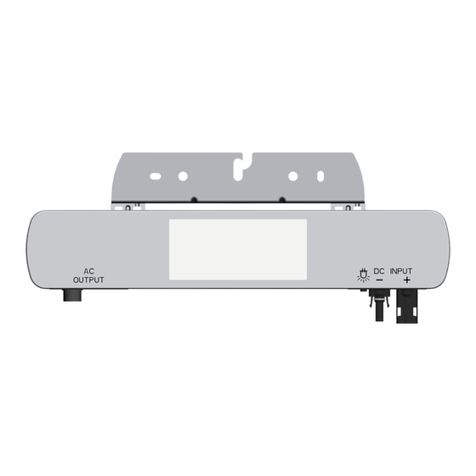
AE Conversion
AE Conversion INV315-50EU Installation guide

AE Conversion
AE Conversion INV250-45EU RS485 User manual
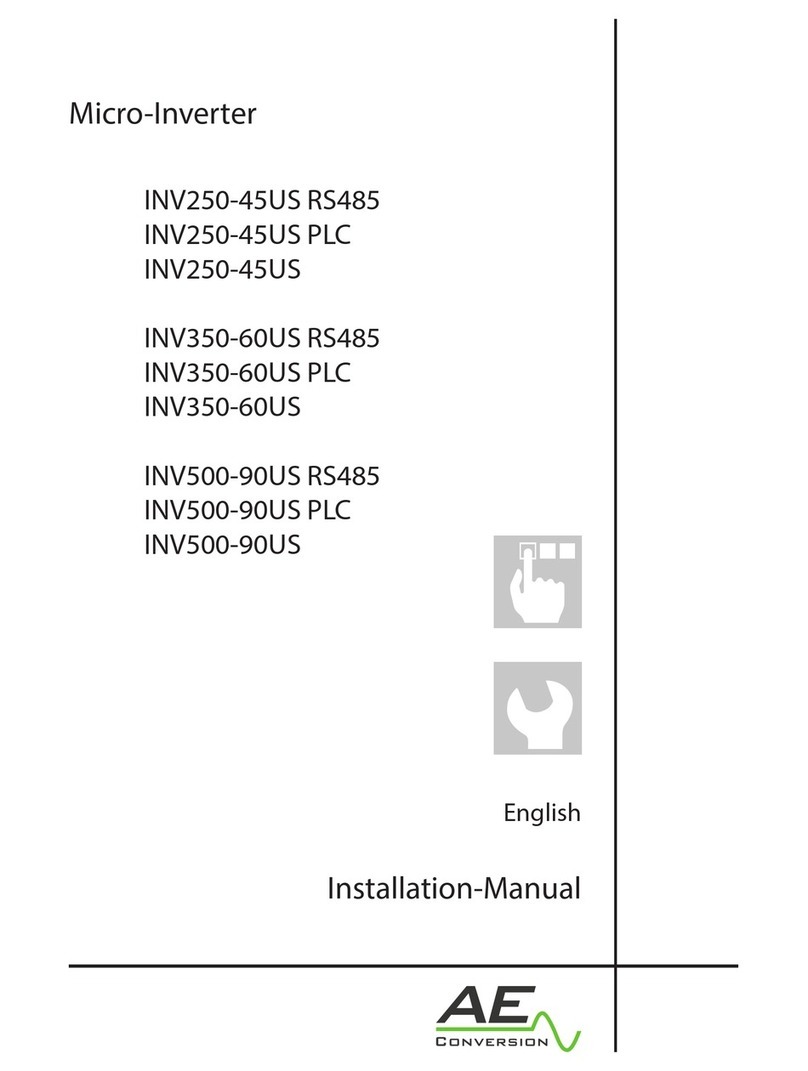
AE Conversion
AE Conversion INV250-45US RS485 User manual
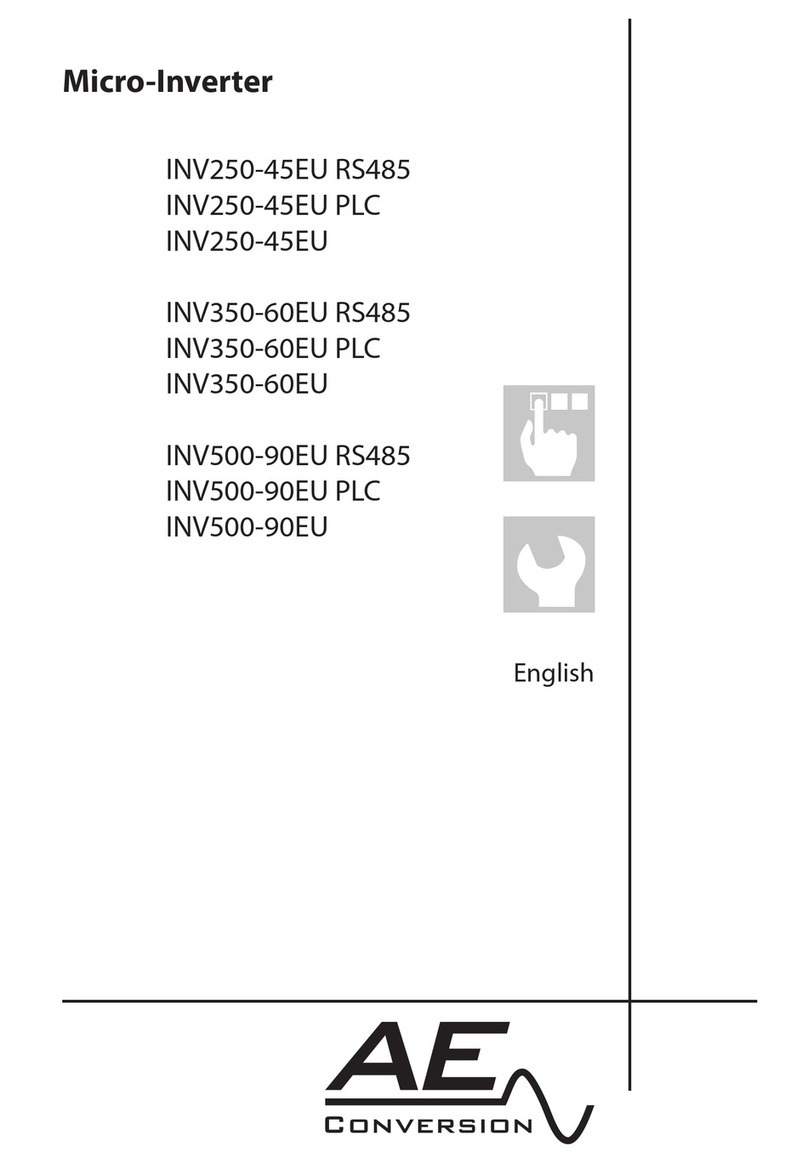
AE Conversion
AE Conversion INV250-45EU PLC User manual
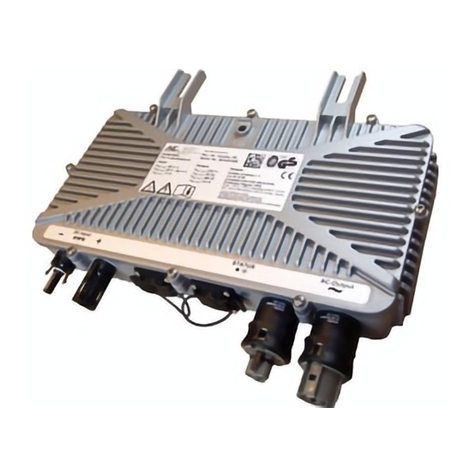
AE Conversion
AE Conversion PS350 User manual
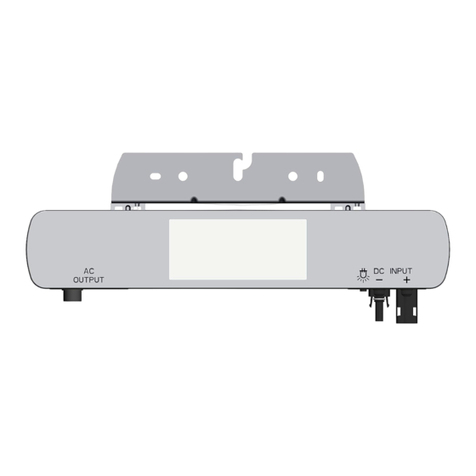
AE Conversion
AE Conversion INV315-50EU User manual
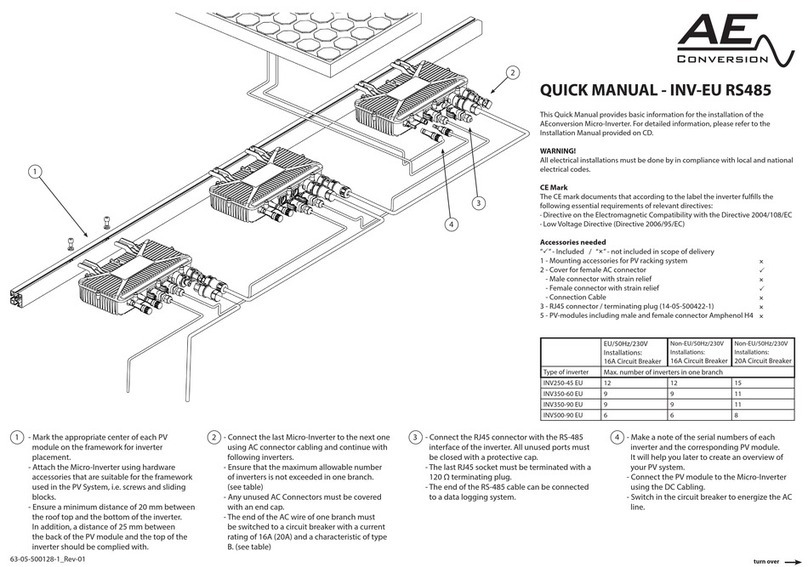
AE Conversion
AE Conversion INV-EU Series Installation guide


